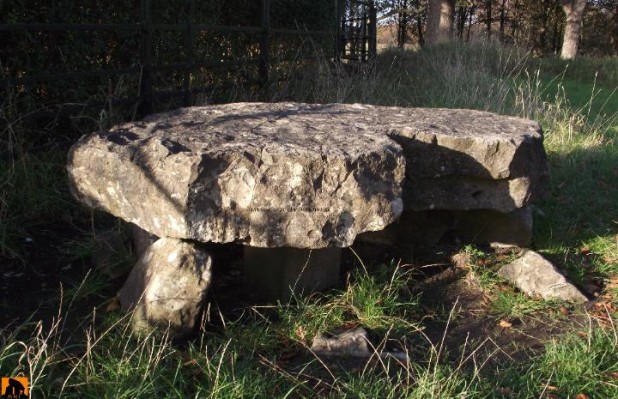For the past few hundred years, Dubliners and non-Dubliners alike have enjoyed strolling through the Phoenix Park, kicking a football around with friends or even deer watching. The Phoenix Park has for many generations been used for the most part as a recreational space. However, evidence for the use of the park by humans goes back much further in time than a few hundred years. This article will examine part of this evidence, in the form of Knockmaree Linkardstown Burial.
The Phoenix Park is an impressive 707 hectares (1752 acres), and is one of, if not the, largest enclosed park within a capital city in Europe. Though it does indeed cover a huge area now, it was originally 2000 acres in size! Construction originally began in 1662 and the park’s boundaries extended to the Royal Hospital, Kilmainham. In 1680 it was reduced by several hundred acres, and has generally remained the same size since (see Figure 1 below).

Figure 1: The Phoenix Park and its environs today. From http://www.phoenixpark.ie/maps/
In the south-western corner of the park, tucked away beside a small cottage and up on a steep slope, next to the Chapelizod Gate entrance (Figure 2), lies a stone monument. This monument is not particularly extravagant or exciting to look at, as it consists only of a large stone (a capstone) placed horizontally on four small stones (orthostats) and a concrete pillar (a later, conservation addition to the monument!). This simple stone monument (see Figure 3) however, is evidence of human activity in this area some 4000 years ago.

Figure 2: Location of Knockmaree Linkardstown Burial. From Ordnance Survey 2006.

Figure 3: The Knockmaree Linkardstown Burial.
The monument is called the Knockmaree Linkardstown cist, or burial, and dates to the Neolithic period (3500-2500B.C.) . Linkardstown cists, or burials, are most commonly found during this period and generally consist of an earthen mound, with a stone built tomb at the centre. Most often, the individuals found within the tombs are adult males, and can sometimes be accompanied by a child. The stones we see today at Knockmaree are what are left of the original tomb, the earthen mound long since gone.
The site at Knockmaree was first discovered in 1838, during landscaping works. It was brought to the attention of the Royal Irish Academy (RIA; the academy for the sciences and humanities, including antiquaries), by a Mr. T. Drummond . When members of the RIA first visited the site, it looked distinctly different from today. They saw a large mound, surrounded by a few smaller ones. Upon excavating the mound and examining its contents, they found the tomb itself and a number of pottery vessels. The description below is the original description of the tomb, by George Petrie: “The tomb consisted of a table, or covering stone, 6feet 6inches in length, from 3 feet 6 inches to 3 feet in breadth and 14 inches in thickness. This stone rested on five supporting stones, varying from 2 feet 6 inches to 1 foot 3 inches in breadth and about 2 feet in height…and there were 5 other stones, not used for supports, but as forming the enclosure of the tomb…” (see Figure 4).
Two adult male skeletons, the skeleton of a dog and a large number of seashells, were all recovered from within the tomb. The shells were all local, from the Dublin coastline, and formed two necklaces, one of which can be seen in Figure 5. The pottery vessels mentioned above were identified as funerary urns from the Bronze Age period (2500-700 B.C.) and date to approximately 25500B.C. Therefore, sometime between the end of the Neolithic and the early Bronze Age, these funerary urns were placed within the mound of the original Linkardstown burial.

Figure 4: The original drawing of the tomb from the Royal Irish Academy’s Report. From Petrie, 1838. Page 188.

Figure 5: One of the shell necklaces found within the tomb, under the skulls of the male skeletons. From Treasures of the National Museum of Ireland Irish Antiquities, 2002, page 73.
Approximately 4000 years ago, at Knockmaree, a Neolithic community came to construct the tomb that would hold the remains of their loved ones. Today, families and friends gather in the Phoenix Park for a fun day out, be it at the zoo or for a picnic in the park. So if, on some sunny Sunday afternoon, you’re strolling through the Park with your loved ones, take a detour to the Knockmaree Linkardstown Burial, and revisit the same place that others came to, 4000 or so years ago.
Further Reading/ Bibliography:
Mc Cullen, J.A. 2009. An Illustrated History of the Phoenix Park; Landscape and management to 1880. Dublin: Stationary Office.
Nolan, B. 2006.Phoenix Park: A History and Guidebook. Dublin: Liffey Press.
Petrie, G. 1838. Report from the Committee of Antiquities, Proceedings of the Royal Irish Academy I, 186-190.
Wallace, P. and Ó Floinn, R. (Eds). 2002.Treasures of the National Museum of Ireland: Irish Antiquities. Dublin; Gill & Macmillan Ltd.
 This article was originally published in:
This article was originally published in:
Fountain News Digital – May 2011 (Issue 4)
We are re-publishing all articles from our past newsletter, Fountain News Digital, and you can view all completed newsletters here. There were nine issues published in total between 2010 and 2012.









